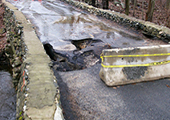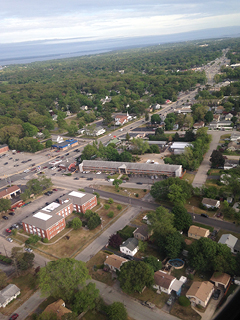Study Purpose
The significance of Narragansett Bay and the state’s urban rivers and ponds to the region’s vitality is widely recognized. These waters form municipal boundaries and traverse the urban landscape. The health of these waters reflect the quality of life for area residents and opportunities for economic prosperity. The Narragansett Bay Watershed encompasses 150 square miles nurturing plants, fish, and wildlife. It is also home to more than two million residents, and is a destination for 10 million tourists each year.
Through our initial work to bring Upper Narragansett Bay communities together to seek a regional solution, it has become clear that our cities and towns face a common set of problems and challenges.

Roadway failure after 2010 storm, Cranston

Common challenges include:
- Flooding of streets, homes, and businesses;
- Deteriorating and undersized infrastructure;
- Habitat destruction and pollution of local ponds, rivers, and the Upper Narragansett Bay;
- Vulnerability to extreme precipitation events;
- An inability to meet funding needs and provide necessary stormwater services;
- Increasing regulatory requirements, non-compliance and enforcement actions; and
- Economic impacts on businesses and tourism.
The Upper Narragansett Bay Regional Stormwater Management District Feasibility Study (Study) began in September 2013 to explore the creation of a regional stormwater district as a coordinated approach that would provide a long-term, sustainable solution to stormwater management for member communities. The solution will address the financial, operational, environmental, and management issues and needs of communities in the Upper Narragansett Bay watershed. Not only does the phased approach position these municipalities to better address water quality and flooding challenges, but to also be better prepared to meet the challenges of climate change.
The benefits of a regional stormwater management district include:
- A stable, adequate, flexible, and equitable source of funding
- Consistent flood mitigation efforts across the region
- An effective means of addressing water quality problems that span across municipal borders
- A cost-effectiveness approach to address technical needs and services
- The ability to address management issues and infrastructure problems of interconnected systems
The Upper Narragansett Bay Regional Stormwater Management District Feasibility Study was structured into three phases. Phase I consisted of the initial feasibility study; Phase II will define the scope and governance of the utility; and Phase III will be implementation. Phase II and III are dependent on favorable results from the previous Phase.

Phase I
The primary purpose of Phase I, which was completed in June 2014, was to gather information to determine if a regional approach to funding stormwater management should be developed for the Upper Narragansett Bay municipalities. The Phase I study was funded by the RI Department of Environmental Management (RIDEM) with in-kind staff contributions from Central Falls, Cranston, East Providence, North Providence, Providence, Pawtucket, Warwick, and the Narragansett Bay Commission (NBC).

Phase I drew five major conclusions:
- The Upper Narragansett Bay region has real, growing, shared, and unresolved challenges in managing stormwater.
- With adequate resources, the expertise is available to address these challenges and the solution would provide tangible benefits to each municipality.
- The necessary solutions will cost more than municipalities are now spending on stormwater management.
- A regional approach will be more efficient and effective than an individual approach.
- A stormwater user fee, based on how much a property contributes to stormwater run-off, is the best and fairest way to pay for the improvements.
For complete information on the study’s findings, read the Upper Narragansett Bay Regional Stormwater Management District Feasibility Study Phase I – Final Report.
Phase II
Phase II, which began in February 2015, involves defining the scope and governance of the proposed stormwater management district. During Phase II, the consulting team and participating municipalities will host stakeholder group meetings to engage and elicit input from key interest groups. Phase II also seeks to build public understanding of the need for a regional district.
The five key outcomes of the Phase II Planning project are as follows:
- Assess current and future operation and capital needs, and cost of services;
- Develop a funding plan for the regional utility;
- Develop an operational, financial, and administrative framework for the regional utility;
- Develop detailed guidance defining the steps and decision-making process for implementation of the regional stormwater management district under Phase III – Implementation; and
- Enhance public awareness of the UNBRSM District and regional issues through planned public outreach.
Phase III
Phase III will explore implementation of the recommendations and results of Phase II.